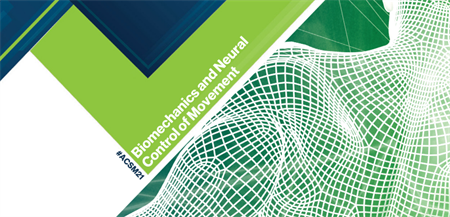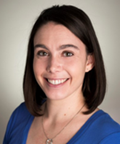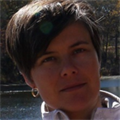Allison H. Gruber, Ph.D., FACSM and Clare E. Milner, Ph.D., FACSM |
May
25, 2021
Each day of the 2021 ACSM Annual Meeting will include a session in the Biomechanics and Neural Control of Movement topical area.
 The Biomechanics and Neural Control of Movement content will kick off on Tuesday, June 1 at 11:30 AM with the virtual presentation of 123 abstracts in our topical area. Check out these posters to see the most up-to-date research on running biomechanics and injury, wearable technology, osteoarthritis and ACL prevention, repair and rehabilitation. Highlights include abstracts on the effect of sleep on healthy gait, metabolic cost of locomotion, gait patterns with Autism Spectrum Disorder, muscle activity and neural reflexes, among other great topics.
The Biomechanics and Neural Control of Movement content will kick off on Tuesday, June 1 at 11:30 AM with the virtual presentation of 123 abstracts in our topical area. Check out these posters to see the most up-to-date research on running biomechanics and injury, wearable technology, osteoarthritis and ACL prevention, repair and rehabilitation. Highlights include abstracts on the effect of sleep on healthy gait, metabolic cost of locomotion, gait patterns with Autism Spectrum Disorder, muscle activity and neural reflexes, among other great topics.
Our showcase highlighted symposium this year will be “The Aging Neuromuscular System and the Protective Effects of Physical Activity,” on Thursday, June 3, 1:15 – 3:15 PM MDT. Presenters include Sandra Hunter, Ph.D., FACSM, Marquette University, Milwaukee, WI; Ashleigh Smith, Ph.D., University of South Australia, Adelaide, Australia; Christopher Sundberg, Ph.D., Marquette University, Milwaukee, WI; and Russell Richardson, Ph.D., University of Utah, Salt Lake City, UT. Age-related changes to the neuromuscular system can be profound leading to functional declines and loss of independence in older men and women. This symposium will highlight how aging affects the physiology and function of the central nervous system and skeletal muscle of older adults as well as the functional consequences such as reduced muscle strength, power and increased fatigability of limb muscles. Importantly, it will highlight physical activity as a powerful tool to protect against declines in neuromuscular function that typically accompany aging. We are presenting this session unopposed by other biomechanics and neural control of movement offerings to give everyone the opportunity to attend.
The other symposia and tutorial sessions for Biomechanics and Neural Control of Movement include the following:
Wednesday June 2, 8:00 – 10:00 AM MDT: “Modern Statistical Approaches for Improved Analysis of Neuromechanical Data: Applications and Fundamental Principles,” presented by Alyssa Evans-Pickett, University of North Carolina at Chapel Hill, Chapel Hill, NC; Garritt Page, Ph.D., Brigham Young University, Provo, UT; Jon T. Hopkins, Ph.D., FACSM, Brigham Young University, Provo, UT; and chaired by Matthew Seeley, Ph.D., Brigham Young University, Provo, UT. Topics include functional data analysis and cluster analysis for studying lower-extremity injury biomechanics and the neuromechanics of chronic ankle instability.
Thursday June 3, 3:30 – 5:30 PM MDT: “Training Load Monitoring of Distance Runners: New Thoughts on an Old Problem,” presented by Max Paquette, Ph.D., FACSM, University of Memphis, Memphis, TN; Irene Davis, Ph.D., FACSM, Harvard Medical School, Cambridge, MA; Trent Stellingwerff, Ph.D., FACSM, Canadian Sport Institute Pacific, Victoria, BC, Canada; Olivier Girard, Ph.D., The University of Western Australia, Crawley, BC, Australia. Topics include the current approaches and new recommendations for monitoring training loads, monitoring training loads for 800m and marathon event runners and internal/external load management using environmental stress.
Friday, June 4, 9:00 – 9:50 AM MDT: “The Art and Science of a Bike Fit,” presented by Andrea Cyr, D.O, University of Illinois College of Medicine, Chicago, IL; Terry Nicola, M.D. FACSM, University of Illinois College of Medicine, Chicago, IL; Joe Ascher, PT, DPT, PhysioPartners Chicago, Chicago, IL. This comprehensive tutorial is presented by a certified bike fitter and medical clinicians who will review the key concepts for an appropriate bike fit to reduce musculoskeletal pain and discomfort. It will be of interest to clinicians, athletes, cycling commuters and recreational cycling enthusiasts alike.
Saturday, June 5, 9:00 – 9:50 AM MDT: “The Value of Movement Assessment Technology in the Clinic and Real World: Application to Running Injuries and ACL Rehabilitation,” presented by Susan Sigward, Ph.D., PT, ATC, University of Southern California, Los Angeles, CA; and Richard Willy, Ph.D., PT, University of Montana - Missoula, Missoula, MT. This tutorial will discuss the effective and efficient use of commercial technologies designed for movement assessments for use in the clinic to quantify movement impairments and intervention progress.
The Biomechanics Interest Group (BIG) will be hosting their virtual meeting the week after the ACSM Annual meeting. Stay tuned to their website and Twitter for details about the event as they become available. The virtual BIG meeting will include a social event, awards ceremony, and a talk dedicated to the 2020/2021 ACSM-BIG Career Achievement Award Winner.
Register today to join us at the 2021 ACSM virtual Annual Meeting!
 Allison H. Gruber, Ph.D., FACSM, is an Associate Professor of Kinesiology in the Indiana University School of Public Health – Bloomington. She is the new Topical Representative for Biomechanics and Neural Control of Movement and the outgoing chairperson of the ACSM Biomechanics Interest Group. Her research interests include the mechanisms of running-related musculoskeletal injuries, wearable technology, and using advanced analysis techniques to better understand biomechanical signals for gait analysis.
Allison H. Gruber, Ph.D., FACSM, is an Associate Professor of Kinesiology in the Indiana University School of Public Health – Bloomington. She is the new Topical Representative for Biomechanics and Neural Control of Movement and the outgoing chairperson of the ACSM Biomechanics Interest Group. Her research interests include the mechanisms of running-related musculoskeletal injuries, wearable technology, and using advanced analysis techniques to better understand biomechanical signals for gait analysis.
 Clare E. Milner, Ph.D., FACSM, is an academic and researcher in rehabilitation sciences and an associate professor in the Department of Physical Therapy and Rehabilitation Sciences at Drexel University. Her research interests are in human movement during daily functional activities, such as walking in people with neurological and musculoskeletal conditions, and in fitness and leisure activities such as running.
Clare E. Milner, Ph.D., FACSM, is an academic and researcher in rehabilitation sciences and an associate professor in the Department of Physical Therapy and Rehabilitation Sciences at Drexel University. Her research interests are in human movement during daily functional activities, such as walking in people with neurological and musculoskeletal conditions, and in fitness and leisure activities such as running.
Follow Clare on Twitter @ClareEMilner